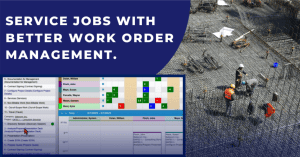Written by FieldConnect
Productivity Tips for Field Service Technicians
Productivity has long been a focus for organizations across industries. Since the 17th century, scientists and business leaders have studied how to improve efficiency. Over time, labor laws have evolved and our methods for measuring productivity have become more sophisticated. Today, field service operations benefit from real-time data and modern management software, helping teams stay informed about staffing, time allocation and overall efficiency.
Yet, unpredictability remains a constant in the field service industry. Field service organizations face the unique challenge of responding to customer calls in real time while maintaining processes and software that drive continuous improvement.
How can teams reliably analyze, measure and respond to productivity when so many variables are outside their control? By embracing data-driven insights, leveraging field service software and optimizing inventory management, organizations can increase productivity even in dynamic environments.
Field service technicians often encounter factors beyond their control—from last-minute cancellations and emergency calls to equipment failures. These unpredictable events disrupt workflows and challenge productivity. Real-time communication with dispatchers and service operations helps technicians make informed decisions on the go.
Despite these challenges, field service technicians and organizations are resilient and adaptable. By focusing on the right tools, using mobile devices for real-time updates and carefully tracking service calls, teams can maintain high efficiency even under unexpected circumstances.
Key Tips for Field Service Technician Productivity
This article outlines strategies and resources to help field service organizations empower their technicians to maintain and grow productivity. Prioritizing customer satisfaction and operational performance can significantly enhance both daily operations and long-term results.
1. Set Clear Productivity Goals
This may seem like an obvious first step, but it is a valuable tip for pursuing more refined productivity strategies. Every strategy must begin with a plan and specific goals in mind.
There are a few things to keep in mind when goal setting. Ensure that any goal strategy involves a formal system of feedback about the progress being made toward each goal. Assign a timeline for regular updates and parameters for information to be provided about the progress. Secondly, assure the goals being set stretch and test your current capacities. You want goals to offer an attainable challenge.
Goal defining and tracking will be dramatically improved with the proper resources. Managers should have access to detailed reports throughout a workday, and this can rarely be accomplished without the appropriate technology and software (which we will offer tips on in our closing section).
2. Track Technician Activities
Accurate technician tracking is crucial—not just for managers but for technicians themselves. When dispatch and back-office teams have real-time insight into technician locations, they can minimize unnecessary travel and maximize productivity.
Mobile devices and service management software enable technicians to share real-time updates on location and job status, leading to faster decision-making and a more agile field service model.
3. Optimize Scheduling Strategies
Reducing travel time starts with effective scheduling. While precise schedules lay the groundwork for productivity, experienced field service organizations know flexibility is essential. The easier it is to modify schedules on the fly, the more productive your team will be.
Consider incentivizing customers to book appointments during periods that are most efficient for your organization, such as low-volume hours or off-peak seasons. Discounts or special offers can help fill these time slots and boost productivity. Effective scheduling strategies and management software minimize downtime and increase efficiency.
Field scheduling software is the most reliable way to implement and adjust schedules. With the right solution, dispatch can make rapid changes and communicate with technicians in real time, reducing costly delays.
4. Streamline Inventory Management
Efficient inventory management is vital for productivity. Time spent searching for parts, tools or resources is time lost. Organize inventory so that essential items are easily accessible, and implement a formal tracking system for parts, equipment and vehicles.
If you lack a formal inventory system, start by tracking usage and building a purchase history with suppliers. Data-driven inventory management helps teams respond to fluctuating demand and maintain consistent service.
5. Empower Dispatchers with information and Training
While much attention is given to equipping field technicians, dispatchers also play a key role in productivity. By providing dispatchers with real-time communication tools and service management software, they can more effectively coordinate field activities.
Well-trained dispatchers can guide customers through initial diagnostics and resolutions, reducing unnecessary technician visits and minimizing No Fault Found Dispatches (NFFD). This ensures technicians focus their expertise where it is most needed, increasing productivity and improving customer satisfaction.
6. Implement Comprehensive Field Service Management Solutions
All these strategies are accelerated and enhanced by the right field service management solution. Look for a mobile application with features like location tracking, navigation, service notes, checklists, expense tracking and appointment management. Real-time updates keep technicians informed about scheduling changes, while advanced tools like augmented reality can support interactive training and remote problem-solving.
Automation is essential. Your solution should automate recurring tasks such as resolution management, service assignments and ticket routing. This allows technicians to concentrate on tasks that require specialized expertise.
Transparent and flexible scheduling features are also critical. Drag-and-drop scheduling empowers administrators to quickly reassign tasks and optimize technician deployment, minimizing disruptions and maximizing productivity.
Evaluate solutions that also prioritize customer experience and provide robust data collection and analysis capabilities. When you combine real-time communication, strong inventory management and advanced software, your field service teams can achieve higher productivity and deliver better service.
If you are interested in learning how TimeLinx Project and Service Management solutions can help your service organization achieve these goals, we invite you to Contact Us .




